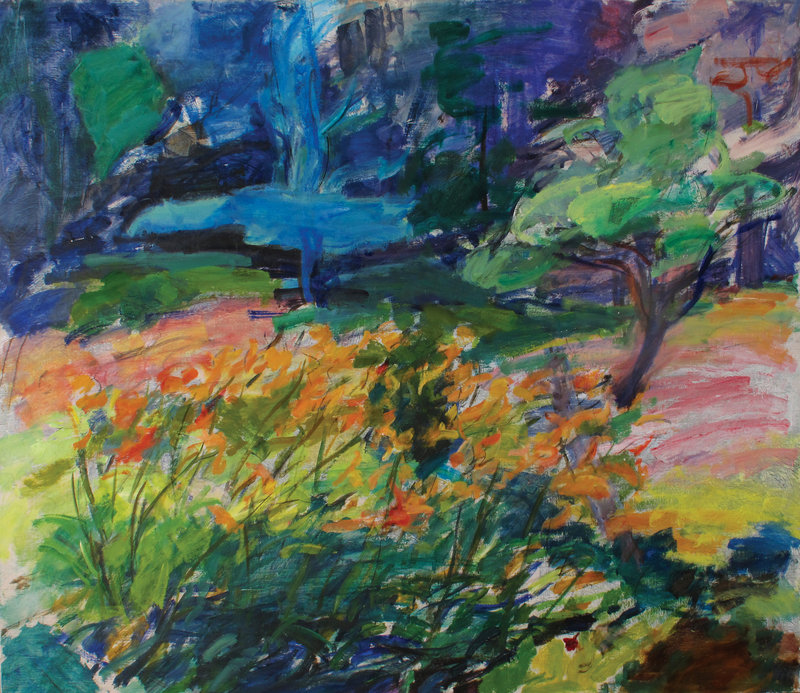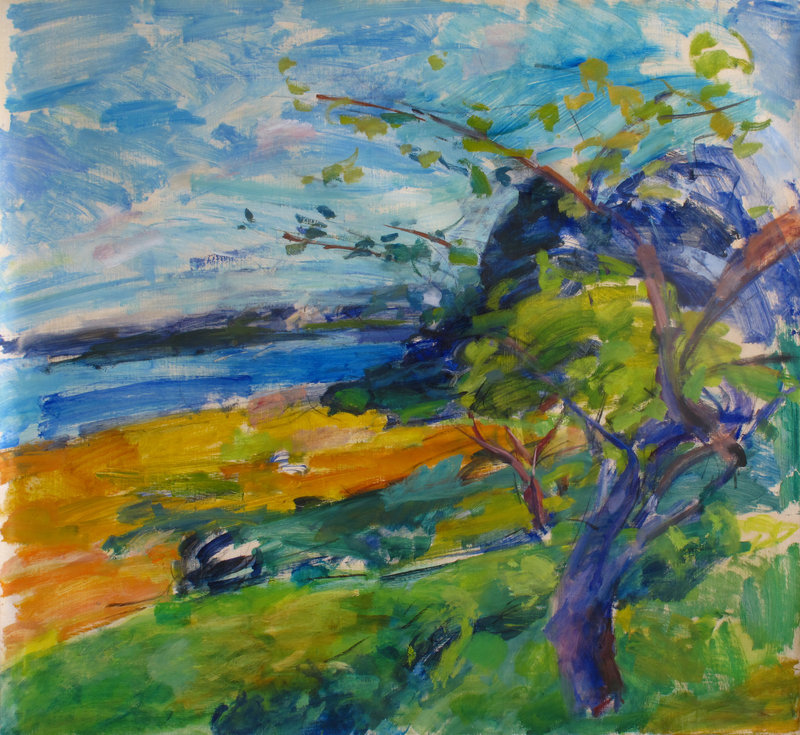PORTLAND – Henry Finkelstein lives on an island and doesn’t paint rocks or water.
“I tend to paint places where human beings are living,” said Finkelstein. “I think that’s why I am not so interested in rocks and water anymore. They may come back, but they are not there now.”
This fall, he exhibits a selection of large, expressive oil-on-canvas paintings at June Fitzpatrick’s Congress Street gallery.
Finkelstein, 52, lives much of the year at Great Cranberry Island, off the coast of Mount Desert Island. It’s a childhood home, where his parents, both artists themselves, spent their summers.
They turned young Henry loose to pursue an islander’s imagination. He explored Great Cranberry inside and out as a youngster, and as an adult settled into the home that his parents first rented in the early 1950s and soon after purchased for $1,500.
He makes his living in New York, where he shares with eager students the wisdom and wonder of mixing and spreading paint. He also has a house in the south of France, which has expanded his painterly horizons.
But his world is small.
His center is a geographic feature known to islanders as The Pond, a sheltered bay that faces Isleford.
“I have a beautiful piece of land up there in Maine,” Finkelstein said by phone from New York. “It’s the nicest part of Cranberry Island. My terrain has a lot of up and down. Different textures. Different flowering bushes and fruit trees that we have put in over the years. It’s just where I go.”
And that is what people see when they look at his paintings.
They are rich in the colors of summer: flowering greens with splashes of yellow, orange, red and blue, with faint white outlines of clapboard and shingled island homes. The paintings are vibrant and alive, and extend the spirit and warmth of summer.
Finkelstein’s work is devoid of human forms but suggests human activity. There’s an overturned skiff in one painting, cultivated gardens in others.
These are not isolated beautiful scenes, but places where people live.
June Fitzpatrick, who runs the gallery, said this show has attracted uncommon attention. That is partly because Fitzpatrick generally does not show a lot of landscape painters. When she does, she draws a different crowd.
But there’s more to the popularity of this show, she said.
Painting students from Maine College of Art have beaten a path to the gallery to look at the work and consider Finkelstein’s loose and observational style. Several times, Fitzpatrick said, motorists who are paused at a nearby traffic signal have found a parking place and come into the gallery to look, drawn by the colors and gestures of the painting in the window.
The show has struck a chord.
“The work has such a pull about it,” she said. “There is a magnetic quality to it.”
Finkelstein’s pedigree made it easy for him to pursue art. His parents both were artists — Louis Finkelstein and Gretna Campbell, both part of the island’s creative community a generation ago. His playmates oftentimes were his parents’ artist friends, although they lived an isolated life.
That is why they chose Cranberry. It was far away from everything, but not necessarily sheltered.
“They wanted very much to be alone,” Finkelstein said. “They had this Emersonian idea of wanting independence, and very much wanted a spot on the coast where they would have their privacy. They found a spot that was precious. There were a lot of (houses) for sale back then, a lot of coastal houses.”
Finkelstein’s parents never forced art on him. They encouraged it by providing pastels and whatnot, but he was free to roam with the other island kids and choose his own entertainment. His sister became an economist, so Finkelstein’s art path was not a given by any means.
“I sort of fell into it, I guess. For better or worse,” he said. “It was lonely sometimes, but I don’t have sad memories of it at all. I know when I was 13, it was all that I did, just go out and draw. After that, I had an adolescent social life, and before that, I had a social life. My parents were working, so I wandered off to play with other kids. Or I stayed around to draw.”
To the best of his recollection, Finkelstein’s “a-ha” art moment came when he was 12. His father was on sabbatical, and the family moved to France for the winter. Finkelstein remembers copying a Henri de Toulouse-Lautrec painting.
“I noticed that color was relative,” he said. “Color was not a fixed thing. I began to see colors in nature I had not seen before. I never left that, really.”
Several years later while at Cooper Union, he benefited from teachers who encouraged him to think about the old masters, particularly the Venetians. His teachers were part of the abstract expressionist generation; Finkelstein’s exposure was varied. As he matured as an artist, he synthesized diverse styles and influences.
As a teacher, Finkelstein talks to his students about the importance of wide exposures, and uses the example of poet T.S. Eliot. “He said you do not have to know every part of your tradition, but it’s good to go beyond one little enthusiasm. I think it shows when people are inspired by one particular era. I think my world would be narrow if I were influenced only by 19th-century painters.”
Those wide influences surface in his work today. He paints from observation, in open air. His work reflects what he sees, but is not representational. It’s certainly not abstract, but includes elements that he learned from the abstract expressionists. Nor is it directly impressionistic.
Fitzpatrick suggested it is because of Finkelstein’s wide sphere of influences that his work feels active and alive. He’s not easily pinned down, and there is much to consider, she said.
It’s been a good 20 years since he has shown in Maine, she noted.
“In that sense, he is new on the scene. A lot of people have not seen his work in Maine before. And yet, he is a very established artist with a large following. It’s nice to get him back showing in Maine again, where he belongs.”
Staff Writer Bob Keyes can be contacted at 791-6457 or at:
bkeyes@pressherald.com
Copy the Story Link
Send questions/comments to the editors.





Success. Please wait for the page to reload. If the page does not reload within 5 seconds, please refresh the page.
Enter your email and password to access comments.
Hi, to comment on stories you must . This profile is in addition to your subscription and website login.
Already have a commenting profile? .
Invalid username/password.
Please check your email to confirm and complete your registration.
Only subscribers are eligible to post comments. Please subscribe or login first for digital access. Here’s why.
Use the form below to reset your password. When you've submitted your account email, we will send an email with a reset code.